Russian-Ethiopian pilot, or As the son of the royal lieutenant created the Air Force of Ethiopia
Russian lieutenant and Ethiopian general
Mikhail Ivanovich Babichev was born on October 14 1908 of the year in Ethiopia. The family history of his parents deserves a separate story. The father of the hero of our article, Ivan Filaretovich Babichev, was a junior officer (according to some data, a cornet, according to others, a lieutenant) of the 25 Kazan Dragoon Regiment. A young cavalryman in 1898 was assigned to an escort of the Russian diplomatic mission in Ethiopia. In those years, the Russian Empire strenuously developed ties with the Orthodox East African country, and the Russian diplomatic missions were frequent guests at the court of Emperor Menelik II. However, Ivan Babichev was hardly satisfied with the service in the embassy guard - the young man of an adventurous warehouse was interested in Ethiopia and dreamed of more serious adventures. So he met Nikolai Leontyev, also a Russian officer who had long served in the Ethiopian court and was one of the founders of the modernized Ethiopian army. Leontiev was also a cavalry officer in the past, but he found his real vocation in the service at the Ethiopian imperial court and made a great contribution to strengthening Ethiopian statehood.
Together with Leontiev, who became the governor-general of the equatorial provinces of Ethiopia, Ivan Babichev took part in the famous journey to Lake Rudolph. True, for this he had to leave the service at the embassy, voluntarily leaving the location of the diplomatic mission. Such a misbehavior could not be ignored and the corresponding reaction of the Russian military authorities - Ivan Babichev was dismissed from military service. The higher command ordered him to return to Russia for further investigation, but the young man, enchanted by Ethiopia, naturally did not obey this order and remained in Africa. He received official forgiveness from the Russian authorities only in 1904, however, he did not return to his homeland and continued to live in Ethiopia, all the more so that at the imperial court his career developed much more rapidly than it could have developed in the Russian Empire.
The Negus of Ethiopia granted Ivan Babichev a noble title. Moreover, the Russian officer who was actively involved in the development of the Ethiopian army was granted by the emperor an estate in Ada, a suburb of Addis Ababa, where Ivan Babichev built the estate. The area of the estate reached 100 acres. In addition, the emperor gave Babichev significant forest land. Coming from Russia, like his older comrade Leontyev, took the post of governor of the province of Vallega. It was located in the extreme south-west of Ethiopia - on the Kenyan border. Kenya at the time was a British colony and one of the most important tasks of the Ethiopian government in the Walleg province was to monitor the activity of British agents who sought to expand the influence of Great Britain in this region of the country.
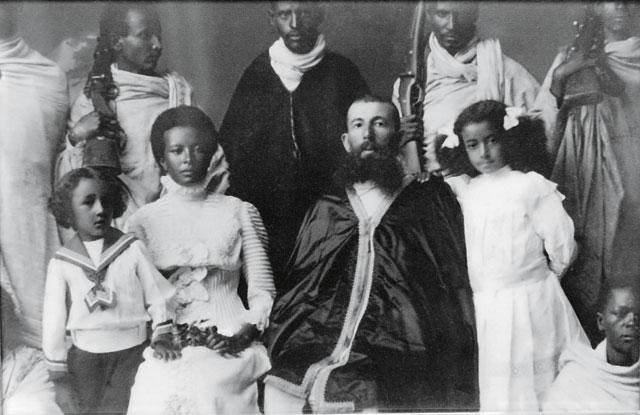
At the imperial court of Ethiopia, Ivan Babichev made a dizzying career for a former foreign national. He received the military rank of "Fitaurari" - one of the highest in the Ethiopian army, giving the right to command the avant-garde units, or even the opportunity to hold the post of commander of a separate army. A.K. Bulatovich, in his book of memoirs, defines the title “Fitaurari” as analogous to the European title “Major General” (Bulatovich AK From Entoto to the Baro River. Report on the journey to the south-western regions of the Ethiopian empire in 1896-1897) - St. Petersburg. : typ. V. Kirschbaum, 1897). Secondly, Babichev intermarried with the imperial surname Solomonides. His wife was Voizero Tekabech Walde Tzadik - Negus's sister-in-law Menelik II. Married to Ivan Babichev, Voizero Tekabech Walde Tsadik gave birth to five children, each of whom received both an Ethiopian and a Russian name. These were three daughters - Marusya (Atcedse Mariam), Sonya (Haregueyevn) and Elena (Helen) and two sons - Victor (Tevondbenai) and Mikhail (Misha). Babichev lived in a luxury worthy of a real Eastern grandee, whom he, in fact, became, becoming a relative of the Ethiopian emperor, the general of the imperial army and the governor of the province.
It should be noted that Babichev was far from being the only Russian officer among the creators of the armed forces of Ethiopia in the early twentieth century. Thus, in 1919, a group of Russian émigrés turned out to be in Ethiopia — officers led by Colonel F. Ye. Konovalov. Among them was A.N. Fermor, in Russia commanded a squadron of the Life Guard of the Ulansky regiment, and in Ethiopia became the instructor of the equestrian unit of the Imperial Guard of Ethiopia.
How was the Ethiopian aviation
Mishka Babicheff in his youth decided to follow in his father's footsteps and become a professional military man, especially for a representative of the Russian-Ethiopian aristocratic family this was the most desirable choice of profession. In the years of his youth, the most popular were armored forces and aircraft. Bear first wanted to go to tank school and become an officer - a tankman, but then became interested in aeronautics. Moreover, just at the turn of the 1920s - 1930s. Ethiopia began to create its own air force. Officially, the year of creation of the Ethiopian Air Force is considered 1929. The direct leadership of the formation process of the country's air force was taken by Prince Haile Selassie. Back in 1922, he visited the British air show in Aden, where he flew on an airplane and after that he set about trying to create an air force in Ethiopia. On August 18, 1929, the first aircraft, the Potez 25 A2, arrived in Addis Ababa. Two weeks later, another plane arrived in the country - the Junkers W33c. Of course, Ethiopia could not compete with major powers in terms of equipping the Air Force, but the imperial army preferred to acquire its own aircraft. The question was raised about the training of flight personnel from among the citizens of Ethiopia. Among the young Ethiopian citizens who wished to serve in aviation was Mishka Babicheff.
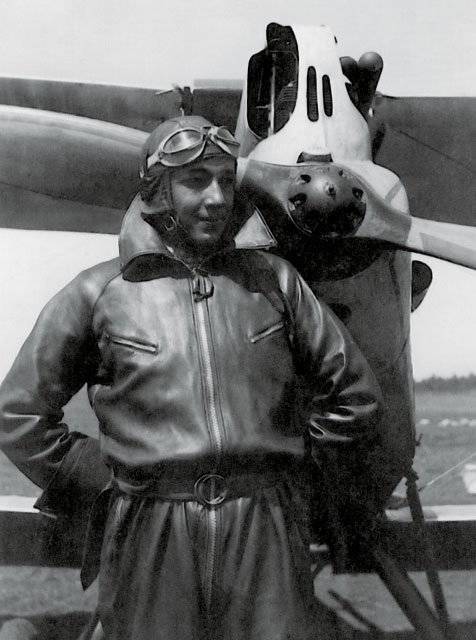
A group of Ethiopian students, trained under the guidance of foreign instructors, was created to train the flight case. In September, 1930, Mishka Babicheff made his first independent flight, after which, in October, 1930, he was given the military rank of lieutenant of the Ethiopian Air Force. To improve his skills, Babicheff was sent to France - to the Air Force Academy, which he graduated with honors in 1932, and returned to his homeland. It should be noted that in those years it was France that was one of the closest allies of Ethiopia. It provided logistical and organizational assistance to Ethiopia, and the history of Franco-Ethiopian relations by this time consisted of several decades and had its roots in the colonial confrontation in East Africa — France vied with Britain and, if Great Britain supported Italy, which claims to be Ethiopian, then France , opposing the British and Italians, assisted the Negus in building and strengthening their own armed forces. In addition to Russian military instructors, the Belgian military mission from 10 instructors, who arrived in the country in 1929, participated in the training of the Ethiopian army. Ethiopian officers began to be accepted into the French military school of Saint-Cyr. In addition, in the Air Force of Ethiopia, two French pilots arrived at the service.
For several years, the total number of aircraft in the Ethiopian Air Force was increased, but never exceeded 20 aircraft. According to some reports, the number of aircraft in the Ethiopian military aviation fluctuated between 12 and 18 units, some of which were faulty. Most of the aircraft was represented by French wooden Potez. In 1928-1936 it was they who formed the basis of the fleet of the Ethiopian military aviation. By 1934, the command of the Air Force of Ethiopia had at its disposal 6 aircraft - Potez biplanes. Three of them were “personified” - they got their own names. The first Potez 25.53 arrived in Ethiopia 18 August 1929 of the year and received the name Nesre Tafari. At the beginning of 1934, he crashed at the racetrack. The second Potez 25.53 was delivered to Addis Ababa on September 22 1929 from Djibouti and was given the name Nesre Asfassowen. It was piloted by the Frenchman Paul Corriger. This aircraft was damaged during landing at Harre in 1930, after which it was transferred to the postal service. The third Potez 25.53 was also brought to 22 September 1929 from Djibouti and was given the name Nesre Makonnen. In June, three Potez 1930 Hispano-Suiza were brought to Addis Ababa in June.
Among the pilots of the Air Force of Ethiopia in 1929-1936. The bulk of them were invited European and American specialists. There were four Ethiopians — Mishka Babicheff, Bahru Kaba, Asfaw Ali and Tesfaye. In addition to them, the Air Force of Ethiopia served Henri Mallet, Baron von Engel and Baron Carl Gustav von Rosen, Ludwig Weber and several other foreign aviation specialists.
Mishka Babicheff was appointed commander of the Ethiopian air force shortly before the next Italian-Ethiopian war. In the period described, fascist Italy resumed its aggressive colonial policy in East Africa, hoping for the expansion of its colonial possessions. As is known, the Italian possessions in North and East Africa included Libya (Cyrenaica, Tripolitania and Fezzan), Eritrea, and Italian Somalia. However, the Italians wanted to clean Ethiopia at the end of the XIX century. Then the Ethiopian army succeeded, in the end, to defend the independence of the state, but the coming to power of the fascists stepped up revanchist sentiments in Italy. First, the Italian leadership sought to unite the colonies of Somalia and Eritrea, which, with the capture of Ethiopia, would become a single territorial space. Secondly, the resumption of colonial expansion against Ethiopia for Italy was a matter of honor, because after losing the battle of Adua in 1895, Italy felt humiliated. After all, the defeat of the Italian army was caused not by the armed forces of any European power, but by the Ethiopians, who, despite their Christian religion and thousand-year history, were always perceived by European colonizers as backward savages. Naturally, Mussolini and his entourage saw the need to commit another act of aggression against Ethiopia, hoping this time not only to avenge the defeat of forty years ago, but also to include Ethiopia into the Italian colonial empire.
Italo-Ethiopian War
In 1934, it became clear that the conflict with Italy could not be avoided. In this regard, the emperor of Ethiopia Haile Selassie began to take accelerated measures to further strengthen the armed forces of the country. The latter in this time period represented the following picture. About ten thousand troops consisted of the Imperial Guard of Ethiopia, organized according to the principle of the modern regular army. In addition to the imperial guard, the Ethiopian armed forces consisted of territorial troops stationed in the provinces and subordinate to their governors, and the militia - tribal units led by tribal leaders.
- Imperial Guard of Ethiopia
In total, Ethiopia could put up about 400-700 thousands of soldiers and officers, but among them only a quarter had sufficient military training. According to the European model, only the Imperial Guard and those military personnel who previously served under contract in the Italian troops in Eritrea and Somalia were trained. The overwhelming majority of the militia did not have any military training and, moreover, even a normal logistics support system — they were instructed to come to collection points with their own reserves of provisions. Many military units were armed not only with outdated guns, but with bows with arrows, spears, Arab and Ethiopian national swords and sabers. Naturally, they didn’t have modern uniforms and normal equipment. The Ethiopian army was armed with about 400 thousands of rifles and shotguns, 200-300 light and heavy machine guns, 200 artillery and 50 anti-aircraft guns, 5 light tanks. The communication of the Ethiopian army was represented by seven radio stations. As for the Ethiopian Air Force, commanded by the hero of our article, they counted about 12 units of aviation equipment.
Significantly, the European powers in 1935 refused to sell Ethiopia weapon and military equipment, thereby showing that they are in actual agreement with Italy and do not object to the colonial enslavement of Ethiopia by the Italian fascists. The European powers for the most part did not support the idea of imposing an embargo on the supply of oil and oil products to Italy submitted by the Soviet Union. Thus, in addition to the Soviet Union and several small countries in Europe and the states of Asia and Latin America, not a single major European power came out in defense of Ethiopia. Even France, which had long-standing political ties with Ethiopia and helped it during the first Italian-Ethiopian war, this time did not support the Negus. Moreover, the French, in exchange for the support of Italy in Tunisia, transferred to the Italians a segment of territory from which the Italian armed forces subsequently launched an offensive into Ethiopia.
In fact, the Italian-Ethiopian war meant a fiasco of such an institution of international politics as the League of Nations, which in the interwar period initially had high hopes in maintaining peaceful and good-neighborly relations between the countries of the world. In addition to Germany, Austria and Hungary, which provided direct support to Italy, the United States of America was engaged in the supply of oil, metal, machinery and equipment, and cotton, pursuing purely economic interests. Britain refused to close the passage of the Suez Canal for Italian ships, as a result of which the Italian fleet could easily enter the Red Sea ports of Eritrea through the canal without bending around Africa. Finally, France detained a cargo of weapons in Djibouti, which the Negus still managed to order.
By 1935, the following copies of aviation equipment were at the disposal of the Air Force of Ethiopia: 4 French Potez 25 A2 French aircraft (they did not have weapons and needed to be seriously repaired); The Dutch Fokker FVIIa monoplane 2 (were in acceptable condition, but lacked spare parts, were used as a military medical service vehicle); German aircraft Junkers W33c; French monoplane Farman; Italian sports aircraft Breda Ba.15; English passenger aircraft Beechcraft Staggerwing; Ethiopia-1 monoplane (the first Ethiopian aircraft assembled from overseas parts under the leadership of the Swedish pilot Ludwig Weber - the personal pilot of the Emperor of Ethiopia). Swedes generally made a major contribution to equipping and reforming the Ethiopian armed forces, including military aviation. In 1935, the Swedish military mission of five officers arrived in Ethiopia. It was thanks to the Swedes that the training of the Ethiopian army was greatly strengthened. In Cholet, a military school of the Ethiopian army was opened, in which 138 students were trained, who formed the basis of the officers of the Ethiopian Imperial Guard.
With regard to the weapons of the Air Force, the Ethiopian aviation had only a hundred ten-kilogram bombs. It is clear that against the Italian aviation the Ethiopian air force looked negligible. Italy has concentrated against Ethiopia a huge military force of almost half a million soldiers - 350 thousands of soldiers and 14,5 thousands of officers, 60 thousands of support personnel. The Italian Air Force, stationed in East Africa, consisted of 510 aircraft, tank units - 300 tanks, artillery - 800 artillery guns. In addition to the Italian soldiers, there were “Askari” in the concentrated group - the servicemen of the native units of the Italian army, primarily the Eritrean, but also the Libyan and Somali. On the night of October 3 1935, Italian troops invaded Ethiopia. The offensive was carried out in three directions - from the territory of Eritrea and from Italian Somalia. The Ethiopian air force was almost completely destroyed by Italian aircraft still on the ground. And even if they had not been destroyed - there were no chances against the Italian aviation, which surpassed Ethiopian aircraft by a dozen times in the number of aircraft, - the Ethiopian air force had not.
Naturally, the Ethiopian army, which lost many times in armaments, combat training of troops, and the organization of supplies, could not defeat the Italian armed forces. An important role was played by the contradictions of the Ethiopian military command. The backwardness of Ethiopia manifested itself in the fact that when appointing army commanders, the principle of noble birth and personal kinship was taken as the basis. As a result, representatives of noble families who did not possess the necessary level of military training and personal qualities turned out to be in the posts of commanders of armies and large units, and talented officers were pushed into the background. Finally, there was also a betrayal of individual feudal lords, who, in fact, did not make any difference to whom they were vassal dependents - the Italian king or the Ethiopian Negus. So, the Sultan Ausa moved to the Italian side. His betrayal in many ways played a decisive role in the advancement of Italian troops into Ethiopia.
- Ethiopian militia
However, we must pay tribute to the courage of Ethiopian soldiers and junior officers. Poorly armed, practically untrained, they compensated for the insufficient development of the country's armed forces with amazing personal prowess. Very often, it was the personal courage of the Ethiopian soldiers that, for all the difference in the level and quality of weapons, the Ethiopian troops managed to crush and even smash the Italian military units. In particular, in the decisive battle of Mai-Chou 31 in March 1936, the Ethiopians even managed to press the Italians a little at the beginning of the battle, although the latter concentrated against Ethiopian troops a grouping with 276 tanks, 210 artillery pieces and hundreds of aircraft. The Ethiopian emperor Haile Selassie, depicting the bravery of his subordinate soldiers, noted that the Ethiopians were not afraid to go with cold weapons against artillery and enemy tanks, but could not do anything against the poisonous substances that the Italian army used in large numbers during the Ethiopian campaign.
However, in the end, the superiority of the Italian army led to crushing defeats of the Ethiopian troops. The emperor of Ethiopia made vain attempts to appeal to the world community: “Do people of the whole world really understand that while fighting to the bitter end, I not only fulfill my sacred duty to my people, but also stand guard over the last citadel of collective security? Are they so blind that they do not see that I am responsible to all of humanity? .. If they do not come, I will say prophetically and without a feeling of bitterness: the West will perish ... ”(quoted in Italo-Ethiopian war / http: //web.archive.org/web/20070214001052/http://hronos.km.ru/sobyt/1935iew.html). However, the appeals of Haile Selassie remained without a proper response from Western states. Ultimately, the emperor left the country. He led the Ethiopian government in exile and, through the territory of French Somalia, he climbed to Palestine and then to Europe.
1 June 1936, Ethiopia joined the united colony of Italian East Africa. The king of Italy, Victor Emmanuel, was also proclaimed emperor of Ethiopia. However, despite the formal proclamation of the country by the Italian colony, hostilities continued in its territory, carried out by the remnants of the imperial army and militia under the leadership of Ethiopian military leaders and aristocrats. The guerrilla war on the territory of Ethiopia was of a large scale and forced the Italian military command to keep an impressive army on the territory of the country.
The situation changed at the end of 1940. The beginning of the Second World War and the entry of Italy into it meant confrontation with the world powers that had previously refrained from helping Ethiopia. Conflict with the UK for Italy, which was never considered a serious militarily country, was no longer within its reach. After all, the British troops outnumbered the Italian army in terms of armament, strength, and combat proficiency. 12 July 1940, the British government officially recognized Ethiopia as its ally, after which it began preparations for the liberation of Ethiopia from the Italian invaders. Moreover, the presence of Italian troops in Ethiopia threatened the security of the British colonies in East Africa.
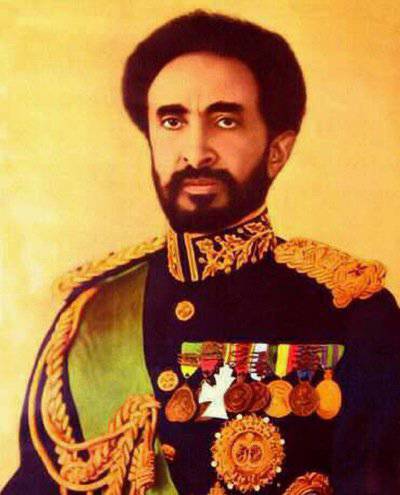 - emperor of Ethiopia Haile Selassie
- emperor of Ethiopia Haile Selassie2 December 1940, the commander of the British armed forces in the Middle East, A. Wavell, ordered the invasion of Ethiopia. Within a few months, British troops that had invaded Ethiopia from three directions — from Kenya, from Anglo-Egyptian Sudan, and from Aden through British Somalia — managed to liberate a large part of the country, including the capital Addis Ababa. The British were supported by the Ethiopian troops, including the native Italian units that had turned to their side and were staffed by Ethiopians. 15 January 1941. Emperor Haile Selassie returned to Africa - he arrived in Anglo-Egyptian Sudan, from where he intended to direct the actions of the Ethiopian troops. For two days, from 4 to 6 on April 1941, fighting continued for the Ethiopian capital, Addis Ababa. The city was liberated by Ethiopian troops, and on May 5 on May 1941, Emperor Haile Selassie returned to the capital of the country. Bear Babicheff was returned to the post of commander of the Air Force of Ethiopia, was awarded high state and military awards of Ethiopia, and later headed the National Civil Aviation Authority.
Embassy in the USSR
In 1944, Mishka Babicheff turned into a diplomat. Perhaps this was due to health problems. In 1044-1947 Babicheff was at work in the USSR, where he held the position of temporary charge d'affaires in Ethiopia. It is significant that here, in the homeland of his father, Babicheff found his love. At the beginning of 1946, the thirty-eight-year-old former commander-in-chief of Ethiopian aviation met Lyudmila Nesterenkova, a student at the Maurice Torez Moscow State Institute of Foreign Languages, and their son Alexander was born on April 6. Unfortunately, the deteriorating health of an Ethiopian diplomat has made itself felt. In January, Babicheff's 1947 struck a heavy stroke. Ethiopian pilot and diplomat paralyzed.
From the Soviet Union, relatives took Babicheff to a neurological clinic in Sweden. In Stockholm, Babicheff was operated on and his health improved slightly - he was able to walk and talk. However, a sick person, of course, could no longer work in a diplomatic mission, and it was decided to evacuate him to Ethiopia. 25 November 1948, he returned to Addis Ababa. However, Lyudmila and their son, Alexander, were not able to leave with their father and husband. The fact is that on February 15 of 1947, the Decree of the Presidium of the Supreme Soviet of the USSR and the Decision of the Political Bureau of the Central Committee of the All-Union Communist Party (Bolshevik) “On the prohibition of marriages between USSR citizens and foreigners” were published. Therefore, the wife and son Babicheff departure from the Soviet Union was closed. Moreover, Lyudmila was given her maiden name, and her son’s birth certificate was withdrawn and a new one was given - to her mother’s maiden name.
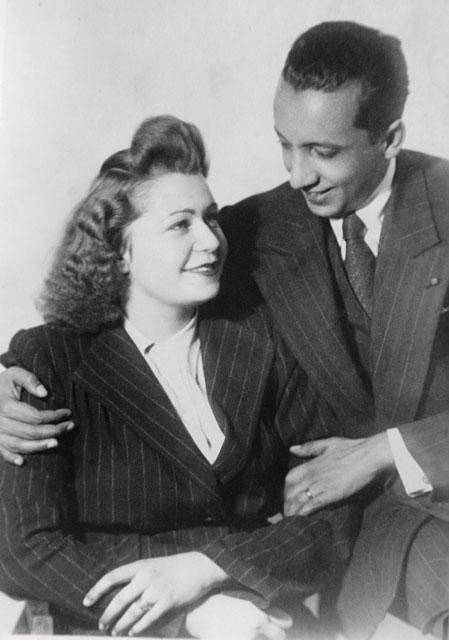
Ten years after the birth of her son, Lyudmila Nesterenkova re-married - a doctor, Haji Shakhnazarov, an Avar by nationality. The son of Babicheff was transferred to the surname of his stepfather and began to be named Alexander Gadzhievich Shakhnazarov (Yukhov V. Secrets of the Ethiopian Court. Interview with A.G. Shakhnazarov // Itogi. No. 44 (908). 4.11.2013.). Bear Babicheff lived in Ethiopia and passed away on December 23 1964, at the age of 56. His grave is located at Heroes' Cemetery in Addis Ababa. Mishka's father, Ivan Filaretovich Babichev, died shortly before his son died - in 1955, at the age of 84. The relatives of Ivan Filaretovich still live in Ethiopia and keep the memory of their famous Russian ancestor and Ethiopian statesman.
Ethiopian Air Force after Babicheff
As for Babicheff's brainchild - the Air Force of Ethiopia, their revival began after the end of World War II. Since, as a result of the Italian-Ethiopian war, almost nothing remained of the Ethiopian Air Force, it was necessary to create military aircraft again. In 1944, a group of African-American war veterans founded an aviation school at Lydeta Airport in Addis Ababa. It was acquired several military aircraft, the purchase of which the government paid for through US military aid and the UK.
The school trained 75 Ethiopian cadets. However, officially, Ethiopia turned to Sweden for help in creating the Air Force. Obviously, two factors played a role. First, Sweden was a neutral country, and secondly - the Swedes took part in the creation of the first Air Force of Ethiopia. So, Ludwig Weber was the first personal pilot of the emperor. An important role in the training of Ethiopian pilots was played by Baron Karl Gustav von Rosen - a Swedish aviator, nephew of the wife of the German military leader Hermann Göring, who was a professional military and served in the Red Cross for a long time. The Swedish military mission trained the Ethiopian military in 1935 - just before the start of the Italian-Ethiopian war, which the Ethiopian leadership also remembered and the merits of the Swedish military instructors always emphasized. Ultimately, it was the Swedes who played a key role in the creation of the new imperial Air Force of Ethiopia. The staff of the Ethiopian military aviation trained Swedish instructors, they also contributed to the acquisition of aircraft and the formation of the bomber and transport aviation squadrons of the Ethiopian Air Force. By the way, the last 1950s to the beginning numbered about 1 thousands of personnel and included a training center and the two named units - the bomber and transport squadron. Somewhat later, already with the support of the United States, the Ethiopian Air Force Fighter Squadron was formed.
In 1953, an Ethiopian cooperation agreement was signed with the United States of America in the military field. The conclusion of this agreement was of great importance for the Air Force of Ethiopia. The US command sent a group of Air Force officers and sergeants to Ethiopia. 25 Ethiopian pilots were sent to improve their skills in the United States. The American military assistance had a particularly significant role in the 1960-1970-s, when neighboring Somalia began to increase its military power, relying on the support of the Soviet Union. At that time, the socialist regime of General Mohammed Siad Barre in Somalia was considered by the Soviet Union as progressive, in connection with which the USSR provided Somalia with comprehensive assistance with both weapons and military specialists.
To create a counterweight to Soviet influence in East Africa, the United States decided to support imperial Ethiopia. The delivery of F-5A jet fighters from the United States was organized. By supplying the Ethiopian army with weapons and carrying out the training of Ethiopian soldiers, the Americans hoped to turn the ancient empire into an anti-Soviet and anti-socialist outpost in East Africa. Incidentally, it is noteworthy that the future communist leader of Ethiopia, Mengistu Haile Mariam in 1967-1970. also underwent training in the United States — in artillery service officers in Fort Leavenworth, Kansas.
After the Ethiopian revolution of 1974, when the monarchy in the country was overthrown, the weakening of cooperation with the United States began. In 1977, the communist regime of Lieutenant Colonel Mengistu Haile Mariam came to power, Ethiopia appealed for support to the Soviet Union. The Soviet leadership, previously cooperating with Somalia, found itself in a difficult situation - two countries at war with each other claimed the status of socialist-oriented countries and sought to cooperate with the USSR. However, the choice was ultimately made in favor of Ethiopia - it was not only Ethiopia’s great prospects compared to Somalia, but also the presence of long-standing cultural ties between Russia and Ethiopia. Cuba also rendered great assistance in the development and strengthening of the Ethiopian air force during the Somali-Ethiopian war, sending its instructors and specialists to help Ethiopia.
Currently, the Ethiopian Air Force is armed with a significant number of Soviet and Russian aircraft. In Ethiopia are honoring veterans of the Second World War. Ethiopians are also remembered about the long-standing friendship between the two countries, embodied in an amazing man with a strange Ethiopian name Mishka Babicheff, who created the Ethiopian national air force.
Photographs from the AG archive were used. Shakhnazarov, published in the publication: Yukhov V. Secrets of the Ethiopian court. Interview with A.G. Shakhnazarov // Results. No. 44 (908). 4.11.2013.
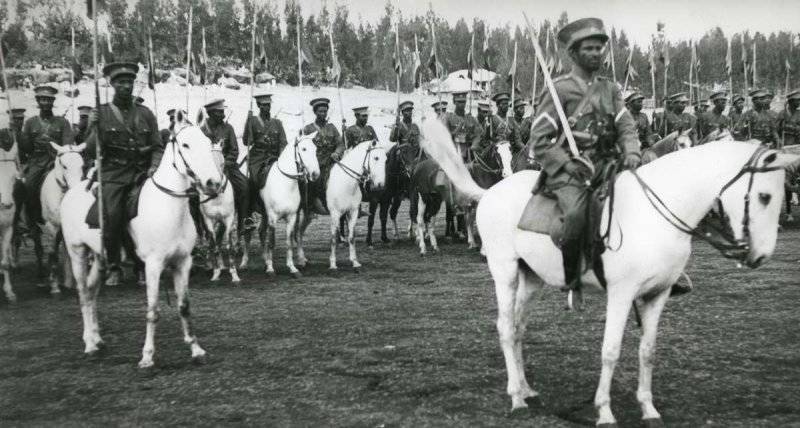
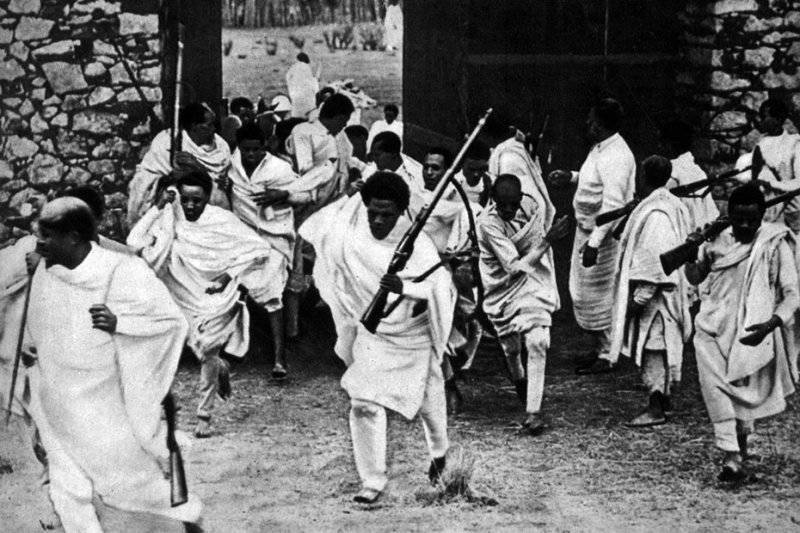
Information